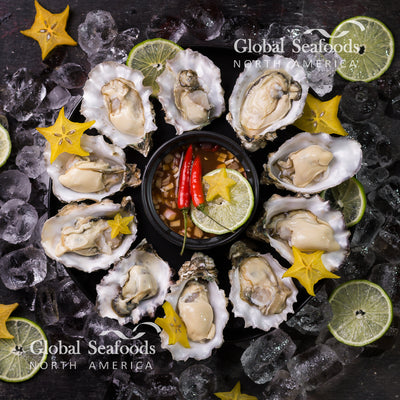Debunking Common Oyster Myths: Facts You Need to Know

Oyster Myths and Misconceptions
Oysters have long been cherished as a delicacy, but myths and misconceptions often cloud their reputation. Are oysters only safe to eat in months with an “R”? Do all oysters taste the same? Let’s dive deep into these questions and separate fact from fiction to help you enjoy oysters confidently and knowledgeably.
Why Understanding Oyster Myths Matters
Misinformation can prevent people from enjoying oysters or even lead to improper handling and consumption. Addressing these misconceptions is essential for food safety and appreciation of this incredible seafood.
For high-quality oysters, visit the Global Seafoods Oysters Collection.
Myth 1: You Can Only Eat Oysters in Months with an “R”
This is one of the most enduring oyster myths. Traditionally, people believed oysters were unsafe to eat from May to August because of warmer waters and higher chances of spoilage.
The Truth:
Modern refrigeration and farming techniques have made oysters safe to consume year-round. During summer, oysters may spawn, slightly affecting texture and flavor, but they remain safe to eat.
Quote: “Refrigeration has revolutionized the seafood industry, making oysters a year-round delight,” says the National Fisheries Institute.
For the freshest options, explore Maine Oysters.
Myth 2: Oysters Are Always Slimy
Many people avoid oysters because they believe all oysters have a slimy texture.
The Truth:
Fresh oysters have a firm, plump texture when properly shucked and served. The "sliminess" often comes from poorly handled or subpar oysters.
- Tip: Pair oysters with a squeeze of lemon or a light mignonette sauce to enhance their natural flavor.
Myth 3: All Oysters Taste the Same
It’s common to assume oysters have a singular taste, often described as "salty" or "briny."
The Truth:
Oyster flavors vary widely based on their origin, water salinity, and diet. For example:
- Tidepoint Oysters (Buy Now) offer a briny, oceanic flavor.
- Miyagi Oysters (Buy Now) have a buttery, sweet profile.
Myth 4: Oysters Are Difficult to Prepare
Many believe preparing oysters is labor-intensive and requires expert skills.
The Truth:
While shucking oysters does take practice, it’s not as challenging as it seems. With the right tools and guidance, anyone can learn to prepare oysters.
Watch easy oyster preparation techniques on the Global Seafoods YouTube Channel.
Myth 5: Oysters Are an Aphrodisiac
The idea that oysters are aphrodisiacs has persisted for centuries, popularized by historical figures like Casanova.
The Truth:
While oysters are rich in zinc, which supports reproductive health, their aphrodisiac reputation is largely symbolic and based on historical lore.
Quote: “Oysters are rich in nutrients, but their aphrodisiac effects are more myth than science,” says the American Heart Association.
Myth 6: Oysters Should Always Be Eaten Raw
Raw oysters are often highlighted as the “best” way to enjoy them, leading some to believe other preparations are inferior.
The Truth:
Oysters are incredibly versatile and can be grilled, baked, fried, or steamed without losing their flavor or nutritional value. Popular dishes include:
- Oyster Rockefeller
- Fried Oysters
- Oyster Stew
For premium oysters to cook with, try Carbajal Oysters.
Myth 7: Farmed Oysters Are Inferior to Wild Oysters
Some purists believe wild-caught oysters are superior in taste and quality to farmed varieties.
The Truth:
Farmed oysters are often cleaner and more sustainable than wild oysters. They are raised in controlled environments, ensuring consistent quality and flavor.
Explore sustainably farmed Cliff Point Petite Oysters.
Safety Tips for Eating Oysters
- Check for Freshness: Fresh oysters have a clean ocean scent.
- Refrigerate Promptly: Store oysters at 35–40°F to maintain freshness.
- Inspect Before Eating: Discard oysters with cracked shells or unusual odors.
- Cook for Safety: If unsure, cook oysters to 145°F to eliminate potential bacteria.
For trusted seafood, visit Global Seafoods.
Nutritional Benefits of Oysters
Oysters are more than a delicacy—they’re a nutritional powerhouse. Packed with:
- Zinc: Supports immune function.
- Protein: Builds and repairs tissues.
- Omega-3 Fatty Acids: Promotes heart health.
Discover More with Global Seafoods
Want to learn more about oysters? Explore these high-quality products:
Watch & Learn
For quick tips and oyster myths debunked, check out the Global Seafoods YouTube Channel.
Call to Action: Enjoy Oysters with Confidence
Oysters are one of nature’s finest delicacies, brimming with flavor, versatility, and nutrition. By understanding the truth behind common myths, you can enjoy them confidently and appreciate their unique qualities.
Shop Premium Oysters Today:
Also in Recipes

How to Cook Live Manila Clams at Home: Fresh, Sweet & Delivered Overnight
Discover how to store, clean, and cook Live Manila Clams at home using simple chef techniques. Learn why these Pacific clams are perfect for pasta vongole, steaming, chowders, and more—plus how to order them fresh in a convenient 10 lb bag shipped overnight.

Boiled Crab for Brunch: The Ultimate Guide to Morning Seafood
Discover the joy of Boiled crab for brunch! Learn how to prepare seafood in the morning, its health benefits, and recipes to make your brunch memorable.







